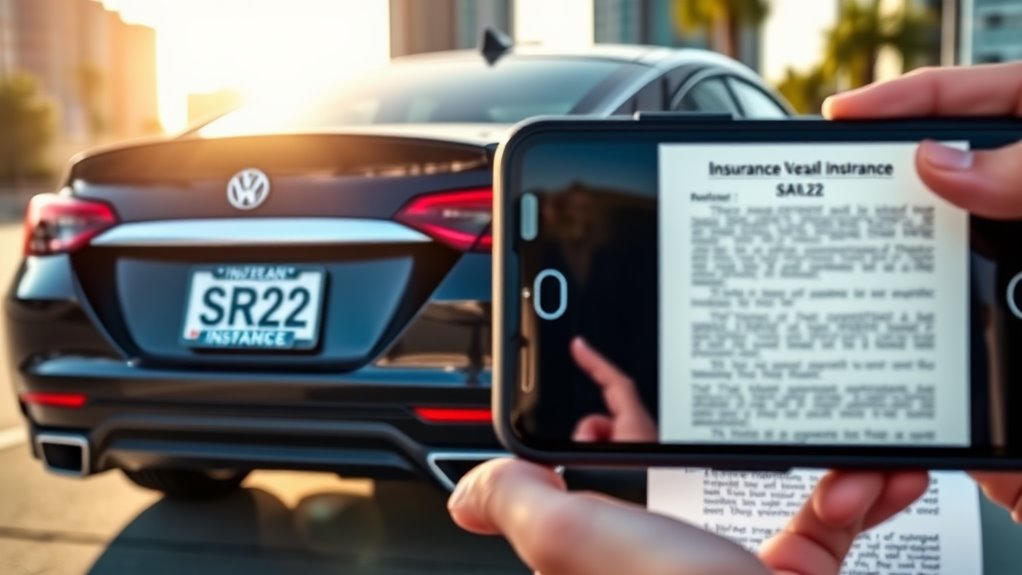Why Do You Need SR22 for Vehicle Registration?
Imagine traversing the roads like a tightrope walker, where one misstep could lead to serious consequences. An SR-22 is more than just a certificate; it's your ticket to proving financial responsibility after a high-risk driving incident. Without it, your vehicle registration could be denied, and your driving privileges might vanish. Understanding the implications of the SR-22 can make all the difference in maintaining your driving status and avoiding further complications. What exactly does that entail?
If you've faced serious traffic offenses like a DUI or driving without insurance, you might need an SR-22 for vehicle registration. An SR-22 is a certificate of financial responsibility that guarantees you're carrying the minimum required auto insurance coverage mandated by your state. This requirement typically arises after serious offenses such as DUI or DWI convictions, driving without insurance, or other high-risk driving behaviors. By filing an SR-22 through your insurance company with the state DMV, you're demonstrating your commitment to maintaining liability coverage, which is crucial for both your safety and that of others on the road. In many states, cheap non-owner SR-22 insurance options are available for those who do not own a vehicle but still need to fulfill this requirement.
The SR-22 is particularly relevant for high-risk drivers. If you've been involved in multiple accidents or have a history of driving without insurance, your state might require you to obtain an SR-22 before reinstating your driving privileges. This requirement varies from state to state but often includes stipulations for driving without a valid license.
It's important to understand that once you're required to file an SR-22, you typically need to maintain it for a specified period, usually ranging from two to five years. Failing to adhere to this requirement could have serious consequences for your driving privileges. A lapse in SR-22 coverage may cause the time period to restart, further complicating your efforts to regain your driving rights.
Maintaining your SR-22 coverage is essential if you want to avoid license suspension. If your SR-22 policy lapses, the DMV will be notified automatically, which could lead to immediate suspension of your driver's license. Continuous coverage is necessary not only to comply with state regulations but also to prevent any legal ramifications that could hinder your ability to drive legally.
It's important to remember that an SR-22 filing impacts your insurance rates and coverage options. High-risk status often leads to increased premiums, but maintaining compliance is necessary for regaining and keeping your driving rights.
The legal implications surrounding SR-22 requirements are significant. If you fail to comply, you risk facing license suspension or revocation. In severe cases, states may enforce SR-22 requirements beyond the typical policy periods, increasing the stakes for noncompliance. Proactively managing your SR-22 status is vital to avoid additional legal issues that could complicate your situation further. Being aware of these implications can help you navigate the complexities of reinstating your driving privileges after serious offenses.
Obtaining an SR-22 involves specific steps that begin with contacting your insurance provider. If your current insurer doesn't offer SR-22 coverage, you might need to secure a new policy from a different company.
The filing process typically requires you to provide your driver's license details and insurance policy numbers. It's vital to inform potential insurers about your SR-22 requirement during the application process to guarantee they can accommodate your needs. The filing fee usually ranges from $15 to $30, but keep in mind that your insurance premiums may increase due to your high-risk status.
Conclusion
To sum up, needing an SR-22 for vehicle registration often feels like an unexpected twist in your driving journey. Just when you think you've got everything under control, a high-risk designation can shake things up. However, by securing this certificate, you not only comply with state regulations but also pave the way to reclaiming your driving freedom. So, while it may seem like a hurdle, it's really a stepping stone toward responsible driving and a brighter road ahead.


